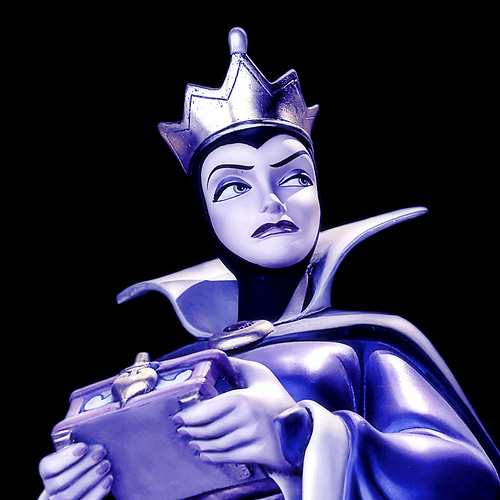Bad Guys Have a Story to Tell
Last week I dove into bad guys in your fiction. Before you say you don’t have a clear antagonist in your story, think about a character that opposes your protagonist. It could even be a good friend. In some instances, supportive characters take on the role of an antagonist, so try to broaden your perspective a bit as we go a little deeper into understanding your antagonist and working on making him/her more human (unless they aren’t human, as might be the case in a sci-fi novel–but they still need to have some agreeable “human” traits, so if you think you can get out of doing this because of the genre you’re writing in, you have another think coming).
Ask: What is the worst trait of your antagonist? Is she heartless? Judgmental? Cruel? Take a moment and challenge your brain to come up with a moment and situation in which you could show a glimpse of exactly the opposite. Last week I gave the example of the wicked stepmother in the movie Ever After, showing how the writer created a scene specifically to reveal a bit of vulnerability of that character. That scene could have been left out of the movie (where she has a “heart-to-heart” talk with her stepdaughter in the bedroom) and the movie would still have been great. That scene was not at all crucial to the plot, not one bit. Yet, I feel that scene is one of the most important ones in the movie, and I’m sure you can guess why. I just love seeing the flip side to the bad guy, getting a peek at their humanity. I guess I just want to believe everyone is redeemable deep down inside. And I think that’s a belief that resonates inside a lot of us. But we can still hate the bad guy anyway.
Give Your Bad Guy a Moment of Hesitation
What does your antagonist want more than anything else? Can you think of showing a moment where she might waver in that desire and reconsider? Where she has a moment of hesitation about the evil she is perpetrating? Have second thoughts? This is where you could get a bit in about their greatest fear because often fear is at the core of why we do sucky things to other people. We lash out and hurt others to prevent ourselves from feeling hurt. And again this goes back to the wound from the past. Just what happened to your antagonist way back when to make him so awful? Does he carry guilt over something shameful he did? Or something he should have done and didn’t?
Once you come up with a good reason for your antagonist opposing your protagonist, you can create a moment where that memory of the past hurt is triggered. Maybe something happens in a scene that makes your bad guy remember what it felt like to have that done to him. Maybe he’s about to beat up his kid and flashes back to when his father beat him and winces at the painful remembrance of that time. You don’t want to give your antagonist a quickie unbelievable change of heart; you just want to show a little of why he is the way he is to garner a little empathy.
Let Your Reader Feel for Him–At Least for a Second
Maybe you think this is a waste of time and counterproductive to your plot. After all–you want the reader to hate your bad guy, not  feel for him. But I’d like to encourage you to try this and see if it doesn’t make that antagonist more believable. The movie The Runaway Jury comes to my mind. Isn’t there a moment at the very end of the movie when Gene Hackman’s character, the lawyer Fitch, is watching Nicholas and Marlee (the heroes) back in their hometown after learning the whole truth about who they are and why they rigged the jury? He seems to be almost sympathetic in his expression, as if he gets why they destroyed his career. He doesn’t say anything, show any remorse–you wouldn’t want that anyway. He’s the bad guy, and we feel he got what he deserved. But I like to think at his moment of understanding you can tell there’s a bit of humanity underneath him. Of course, in your novel, you have to find another way to show this sensitivity, and it can be done through the eyes of another character (maybe your protagonist sees something in her antagonist’s face), in the antagonist’s thoughts or deep POV, or by some subtle action they may engage in that shows they have some feelings.
feel for him. But I’d like to encourage you to try this and see if it doesn’t make that antagonist more believable. The movie The Runaway Jury comes to my mind. Isn’t there a moment at the very end of the movie when Gene Hackman’s character, the lawyer Fitch, is watching Nicholas and Marlee (the heroes) back in their hometown after learning the whole truth about who they are and why they rigged the jury? He seems to be almost sympathetic in his expression, as if he gets why they destroyed his career. He doesn’t say anything, show any remorse–you wouldn’t want that anyway. He’s the bad guy, and we feel he got what he deserved. But I like to think at his moment of understanding you can tell there’s a bit of humanity underneath him. Of course, in your novel, you have to find another way to show this sensitivity, and it can be done through the eyes of another character (maybe your protagonist sees something in her antagonist’s face), in the antagonist’s thoughts or deep POV, or by some subtle action they may engage in that shows they have some feelings.
Walk a Mile in Her Shoes
A great exercise Donald Maass had us “breakout novelists” do at his workshop was to rewrite our synopsis from the POV of our antagonist. At first I thought that was a little weird, since I didn’t write my original synopsis from my protagonist’s POV–I wrote it from my POV, but I gave it a try. Wow, it was great! Suddenly a different tone took over (and my antagonist in Conundrum is patterned after my mother, so I really didn’t want to feel any compassion for her at all or somehow justify her behavior). What happened was I began to see, as I outlined the plot and premise from her take, was a whole new side to the story. She looked at the whole situation and conflict with her daughter in an entirely different way and really believed that what choices she was making were justified–they were for her daughter’s own good, in her mind. Writing this caused me to mentally step back again, and it made my antagonist so much more understandable. How can you truly hate someone who does horrible things to their family if deep in their heart they really believe they are doing the right, moral, and best thing for those (they think) they love? From that, I was able to rework some scenes to give my evil mother character more sides, and I hope I made her at least a bit more believable and well rounded.
This week, if you’re game, try writing your synopsis in the POV of your antagonist. Or is you don’t have one written or want to try something different, just freewrite in her POV and let her explain the moral reasons for behaving the way she does. Let her talk about her past and how she became who she is. She may not think she’s evil at all. Or she may feel her cruelty is quite justified. Then work some of this into your novel and see if your stereotyped character now looks a little more real.












Yes, our protagonists need complicated and overwhelming antagonists. Some stories require the ultimate evil for the hero to conquer. They all require a constant influx of obstacles. I’ve had antagonist’s stories take off from the key board, only to require more exploration…a dangerous proposition 😀 when trying to shorten a story.
Thank you for another stimulating post.
Suzanne … such good advice. SAILING DOWN THE MOONBEAM was “my” memoir, but as I was doing it, I wrote so many of the scenes from both my POV and from my husband’s. I learned quite a lot from the exercise, and I know it made the memoir more even handed. And it applies to the novel I’m working on right now. I want my readers to like my antagonist enough to be shocked when they find out what she’s really like. Although it’s all told from my protagonist’s POV, writing some of the scenes from the other POV helps create a problematic character that people will like.
A most interesting post. I am most intrigued by characters who encompass elements of both traditional ‘good’ and ‘bad’, who are wholly neither one nor the other but a more complex blend that ultimately seems much more authentically three-dimensional.
Excellent post! Very informative. Going to keep it as a sort of ‘checklist’ to peridoically consider 🙂
The bad guy doesn’t necessarily need to have a story to tell. That’s not his (or her) purpose. He or she only needs to have a story or just a motivation if he (or she) is a character. The villain’s purpose is to provoke the journey – see http://www.clickok.co.uk/index4.html
In my novel WIP my antagonist is the character my recently widowed protagonist finds herself simultaneously irritated by and attracted to. It isn’t that he does anything particularly mean to her, it’s more her misunderstanding certain actions and the protagonist rebelling against the feelings she is beginning to have toward him. The situation they find themselves in (he had a connection to her dead husband) almost plays the role of the antagonist just as the protagonist’s feelings and emotions contributes to the situation. Does that make sense to you?